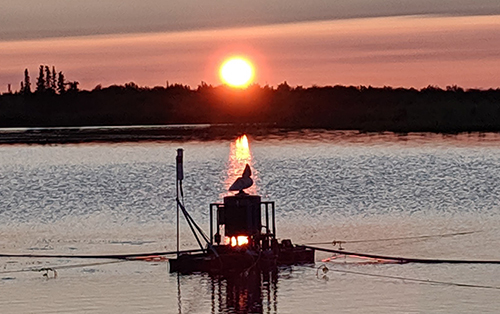#MoveTheDate
2-4.5
Days
If 50% of the approximately 3,000 methane-emitting coal mines worldwide implemented methane capture and destruction technology, we could move Earth Overshoot Day by 2-4.5 days.
What is the solution?
Capturing concentrated sources of methane seeping into the atmosphere (such as that from active and abandoned coal mines, natural methane vents, and abandoned landfills) and burning or using it onsite.
How does it #MoveTheDate?
Methane is a potent greenhouse gas — 28 times more potent than CO2 over 100 years. It can be turned into CO2 by simply burning it, reducing its global warming potential by 96.4%. Methane emissions from coal mines alone make up 1.1-2.5 gigatonnes of CO2e per year worldwide*, with other sources increasing methane’s impact.
How is it scalable?
Destroying methane from sources like gassy coal mines, natural methane vents, and abandoned landfills is a triple win, drastically reducing the global warming potential while earning revenue from carbon offset markets to pay for project equipment and share with landowners.
What is the solution?
Capturing concentrated sources of methane seeping into the atmosphere (such as that from active and abandoned coal mines, natural methane vents, and abandoned landfills) and burning or using it onsite.
How does it #MoveTheDate?
Methane is a potent greenhouse gas — 28 times more potent than CO2 over 100 years. It can be turned into CO2 by simply burning it, reducing its global warming potential by 96.4%. Methane emissions from coal mines alone make up 1.1-2.5 gigatonnes of CO2e per year worldwide*, with other sources increasing methane’s impact.
How is it scalable?
Destroying methane from sources like gassy coal mines, natural methane vents, and abandoned landfills is a triple win, drastically reducing the global warming potential while earning revenue from carbon offset markets to pay for project equipment and share with landowners.
Roughly 37% of methane emissions come from highly concentrated sources at relatively few sites. Therefore, methane capture devices installed on a small number of sites could have a huge impact. Implementing existing technology to capture and use or burn methane at 3000-6000 sites worldwide could have the equivalent greenhouse gas impact of taking 100 million cars off the road. For many of these sites, carbon market revenue creates the opportunity for a sustainable business while fairly compensating landowners for their part in the installation.
Frost Methane has developed low cost equipment which occupies a small amount of space and can handle a variety of continuous and intermittent methane sources. Frost Methane tackles projects end-to-end through site evaluation, installation, financing, and revenue generation in carbon markets. Data gathered from the sites is shared with the scientific community to help researchers better understand concentrated methane emissions and refine climate models and predictions.
Interested in learning more? Are you a property owner with an old landfill or old mining activity underground? Do you operate an active coal mine? Do you live near a permafrost or a natural methane vent? Frost Methane can help you participate in the carbon market economy and generate revenue by keeping methane out of the atmosphere. For more information, visit https://frostmethane.com/ or email info@frostmethane.com.
Sources:
* Kholod, N. et al. Global methane emissions from coal mining to continue growing even with declining coal production. Journal of Cleaner Production 256, 120489 (2020). https://doi.org/10.1016/j.jclepro.2020.120489
Anthony, K. M. W., Anthony, P., Grosse, G., & Chanton, J. (2012). Geologic methane seeps along boundaries of Arctic permafrost thaw and melting glaciers. Nature Geoscience, 5(6), 419-426. https://www.nature.com/articles/ngeo1480
There’s no benefit in waiting!
Acting now puts you at a strategic advantage in a world increasingly defined by ecological overshoot. Countless solutions exist that #MoveTheDate. They’re creative, economically viable, and ready to deploy at scale. With them, we can make ourselves more resilient and #MoveTheDate of Earth Overshoot Day. If we move the date 6 days each year, humanity can be out of overshoot before 2050.

